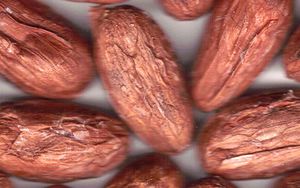|
|
|
CACAO
the intercollegiate annotation competition!
|
| From the beginning, Community Assessment of Community Annotation with Ontologies (CACAO) was a competition for teams of undergrads around the world to improve the functional annotation of genes. CACAO was developed and run at Texas A&M University, along with many other institutions. The below information is retained for archival purposes.
In 2024, CACAO is relaunching as Creating Annotations through Critical Analysis of Original research and will migrate to a new site at cacao.wiki.
If you are interested in participating, please email us.
|
About CACAO
|
The rapid advances in genomics technology mean that we are discovering genes faster than we can figure out what they do. For most new sequences, gene function will be inferred by comparison with well-studied systems that have published experimental data. This means that the quality of functional annotation for these systems is very important for the future of biology. This course aims to remedy the problem of available curators by leveraging undergraduates -- teaching them how to critically read scientific literature and make useful and correct annotations. We think that the large number of biology-related undergraduates at world-renowned institutions are a vast untapped resource for biocuration.
The Community Assessment of Community Annotation with Ontologies (CACAO) is a project to do large-scale manual community annotation of gene function using the Gene Ontology as a multi-institution student competition. In CACAO, teams of students get points for making annotations, but can also take points from competitors by correcting their annotations. Annotations that are judged to be correct will be submitted to the GO Consortium for incorporation into the overall annotation of gene products in major databases. CACAO teams can be run as courses or as club activities, and the scope of CACAO annotation can be any protein in UniProt where students can find experimental literature supporting appropriate GO annotations.
|
The Competitions
|
|
|
|
|
For Instructors
|
Course Materials
Instructors may find the following resources helpful.
Downloadable Biocurator Training Powerpoints
Note: The wiki has changed since these power points creation; but still feature useful tips and instructions
Recruitment Flyer used at TAMU
|
|
|
Help for Students
The 6 parts to making a GO annotation
- Find a suitable paper about a protein on PubMed (no review articles, must have a PMID, must have data in it about the protein)
- Find the same protein in UniProt (same species, strain, organism)
- Use the UniProt accession to make a page for the protein on GONUTS (make sure you are signed in, then click on "Create New Gene Page" on the left & paste the accession # in the box)
- Find a suitable GO term based on figure(s)/table(s) in the paper (check the figure legend & figure description in the text for key words. then search on GONUTS, QuickGO or AmiGO for the key words)
- Pick a suitable evidence code based on how the protein was characterized
- Enter your GO annotation on the protein's page in GONUTS, complete with notes (figure(s) or table(s) that support your annotation).
General
If you're having any issues, first make sure you are logged in on GONUTS!
→ The helpful handouts for students page has several documents that address PubMed searches, Evidence Codes, a guide to making annotations, and more. (IMPORTANT!)
- The Gene Ontology Help page is an alternative, general explanation to just what you're doing, why it's important, and what's involved. Read over this short guide if you're still completely lost as to what CACAO is all about, and don't worry- email us for more help.
- Help:CACAO Errors describes errors made by CACAO students and how to avoid them
- Finally, the links at the bottom of the page (under Pages in category "CACAO") may be helpful.
Biocurator Training Videos
See all the training videos at our GONUTS TAMU YouTube channel
Evidence codes
→ The helpful handouts for students page also has several handouts including the Evidence Code Decision Tree and a "Sampler" sheet listing experiments that are typically used to support each evidence code (IMPORTANT!)
→ This Guide to Evidence Codes is an at-a-glance-guide to the codes you can use for CACAO and how/when they are used (IMPORTANT!)
→ Since 2019, CACAO has transitioned to using ECO codes for evidence.
- Additionally, ECO codes can be searched at QuickGO.
Papers/PubMed
Assessing Annotations
Still Stuck?
We are more than happy to answer questions by email or video chat. We will answer emails FROM ANY SCHOOL as fast as possible. However, be warned that if you wait until the last day or two of a round (especially the last round) we might not be able to answer by the round deadline.
If you're on the Texas A&M campus, you can also email us to set up a meeting. Meetings are HIGHLY recommended over just trying to see if we're around when you drop in!
|
|
Links and Other Resources
|
|
Subcategories
This category has the following 49 subcategories, out of 49 total.
Pages in category "CACAO"
The following 23 pages are in this category, out of 23 total.
Jump to pages starting with:
A B C E F G H I L R S W

